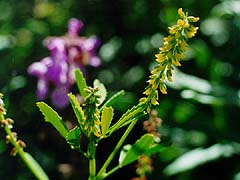
Beans & Peas. But also some trees, hedges, clovers, & vetches. Almost all have the distinctive "pea-like" flower, so often referred to in nature guides: 5 sepals, 5 petals, 10 stamens, and a single compartment pistil that developes a single row of seeds. The two lower petals are fused along their edges, to form the "keel", the two lateral or side petals often stand out from the keel to form the "wings", and the upper petal, usually the largest, forms the banner.
The fruit, when dry, usually splits open forcefully, effectively scattering the seeds. I have heard stories of walking along the trails on Montara Mountain while the Lupine are popping, but have yet to experience this. (Lupines, both annual and perennial variety, make wonderful garden plants, and can easily be propagated from seed.)
